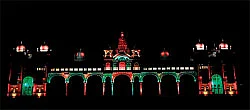Not many people in Mysore know that every evening, except Sunday, the Amba Vilas Palace premises goes completely dark and the history of the six-hundred-years of the Wadiyar dynasty unfolds with breathtaking sound and light effect. N Niranjan Nikam witnesses this spectacle and comes back impressed

The Amba Vilas Palace or more popularly the Mysore palace breathes history in every inch of the vast territory in the heart of the city. Enter it from any side and it takes one’s breath away to see the sheer magnificence of the Indo-Sarcenic architecture.
The one way to understand this rich history of the city is through story telling and that is exactly what the sound and light show (Son et lumiere) being held in the Mysore palace from 7 pm to 7.45 pm every day, except Sunday, tries to achieve. Like any history replete with intrigue and controversy, the scripting of this show was also a no different.
The script written by linguist Lingadevaru Halemane was opposed by Srikanta Datta Narasimharaja Wadiyar, the last scion of the royal family. Finally it saw the light of the day last May.
As one enters the Mysore Palace Board, the newly furnished office inside the palace premises truly reflects the heritage value of the place. The durbar chairs for the visitors to sit has been redone.
“The sound and light show begins with the legend of Goddess Chamundeshwari vanquishing Mahishasura. Then the history of the Waidyars from 1399 to 1947 is told in a very beautiful way,” said the deputy director of the Mysore Palace Board T S Subramanya.
“As the show is in Kannada right now, the visitors are not many. But this does not deter the foreigners from coming and witnessing the spectacular show. Many of them do not understand the language, but they like to soak in the atmosphere,” he told City Herald.
As the lights are switched off and the sound and light action begins one is transported into a completely different world. It is so mesmerising that one even forgets the small inconveniences like the mosquito menace even as it starts sucking blood on your face.
The narration of the history is very good and the valour, the bravery, the treachery, music, art, dance and literature everything comes alive.
Little do we know that Mysore was first called Hadinadu. The moment the river Cauvery takes over with her sing-song voice, the narration, as the history moves from Wadiyars to Hyder and Tipu in Srirangapatna, it is sheer poetry.
Every inch of the space inside the palace is very well used as the lights with different colours like red, yellow, green and orange dance and illuminates the many temples, trees, domes, minarets and towers inside the palace premises.
Earlier to this as the Wadiyar dynasty from 1399 starting with, “Vijaya and Krishna of the Yadu dynasty hailing from Dwaraka in Gujarat came to Mysore, after visiting Melkote on a pilgrimage. The two royal princes took shelter at the Kodi Bhyraveswara Temple, which was close to the Doddakere, from where people of then small city of Mysore fetched water for drinking and daily chore. At dawn, they heard some women, while washing clothes discussing the distress situation of the young Princess Devajammanni. The death of her father, Chamaraja, the local ruler, had landed her and her mother the queen, in trouble.
Taking advantage of the situation, the neighbouring chief of Karugahalli, Maranayaka, began demanding the kingdom and the princess in marriage.
Taking the help of a Jangama Odeya, a Shaivite religious man, the two chivalrous brothers came to the rescue of the distressed Maharani and the Princess. Mobilising troops, they killed the Karugahalli chief and his men and saved the Mysore royal family and their kingdom. A happy princess married the elder brother, Vijaya, and he became the first ruler of the Yadu dynasty,” a story which every young Mysorean needs to know and understand about the proud heritage that we are all bestowed with, said a few witnessing the show.
As the show ended a Tamilian group who had watched the show was very impressed. “I am working near Maddur in a sugar factory. I am used to a few Kannada words and it is very surprising that I enjoyed the show thoroughly as I could follow most of it,” he said.
An Italian group who were also taking pictures said that as Kannada was an alien language to them they could not understand anything but they thoroughly enjoyed the show.
“The English version of the show is getting ready and there is every possibility that by April it will be on,” said Subramanya.
Focus
However, the show can still be improved. The focus should be laid on the Dasara celebrated during the time of Nalwadi Krishnaraja Wadiyar and the last ruler Jayachamraja Wadiyar, as there are still many alive who have witnessed this magnificent spectacle. But sadly, the show in the end focuses on the current Dasara celebrations ‘Nada habba,’ which signifies only sound and fury and total cacophony.
